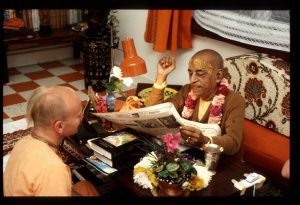SB 3.24.10

A.C. Bhaktivedanta Swami Prabhupada
TEXT 10
- bhagavantaṁ paraṁ brahma
- sattvenāṁśena śatru-han
- tattva-saṅkhyāna-vijñaptyai
- jātaṁ vidvān ajaḥ svarāṭ
SYNONYMS
bhagavantam — the Lord; param — supreme; brahma — Brahman; sattvena — having an uncontaminated existence; aṁśena — by a plenary portion; śatru-han — O killer of the enemy, Vidura; tattva-saṅkhyāna — the philosophy of the twenty-four material elements; vijñaptyai — for explaining; jātam — appeared; vidvān — knowing; ajaḥ — the unborn (Lord Brahmā); sva-rāṭ — independent.
TRANSLATION
Maitreya continued: O killer of the enemy, the unborn Lord Brahmā, who is almost independent in acquiring knowledge, could understand that a portion of the Supreme Personality of Godhead, in His quality of pure existence, had appeared in the womb of Devahūti just to explain the complete state of knowledge known as sāṅkhya-yoga.
PURPORT
In Bhagavad-gītā, Fifteenth Chapter, it is stated that the Lord Himself is the compiler of Vedānta-sūtra, and He is the perfect knower of Vedānta-sūtra. Similarly, the Sāṅkhya philosophy is compiled by the Supreme Personality of Godhead in His appearance as Kapila. There is an imitation Kapila who has a Sāṅkhya philosophical system, but Kapila the incarnation of God is different from that Kapila. Kapila the son of Kardama Muni, in His system of Sāṅkhya philosophy, very explicitly explained not only the material world but also the spiritual world. Brahmā could understand this fact because he is svarāṭ, almost independent in receiving knowledge. He is called svarāṭ because he did not go to any school or college to learn but learned everything from within. Because Brahmā is the first living creature within this universe, he had no teacher; his teacher was the Supreme Personality of Godhead Himself, who is seated in the heart of every living creature. Brahmā acquired knowledge directly from the Supreme Lord within the heart; therefore he is sometimes called svarāṭ and aja.
Another important point is stated here. Sattvenāṁśena: when the Supreme Personality of Godhead appears, He brings with Him all His paraphernalia of Vaikuṇṭha; therefore His name, His form, His quality, His paraphernalia and His entourage all belong to the transcendental world. Real goodness is in the transcendental world. Here in the material world, the quality of goodness is not pure. Goodness may exist, but there must also be some tinges of passion and ignorance. In the spiritual world the unalloyed quality of goodness prevails; there the quality of goodness is called śuddha-sattva, pure goodness. Another name for śuddha-sattva is vasudeva because God is born from Vasudeva. Another meaning is that when one is purely situated in the qualities of goodness, he can understand the form, name, quality, paraphernalia and entourage of the Supreme Personality of Godhead. The word aṁśena also indicates that the Supreme Personality of Godhead, Kṛṣṇa, appeared as Kapiladeva in a portion of His portion. God expands either as kalā or as aṁśa. Aṁśa means "direct expansion," and kalā means "expansion of the expansion." There is no difference between the expansion, the expansion of the expansion, and the Supreme Personality of Godhead directly, as there is no difference between one candle and another—but still the candle from which the others are lit is called the original. Kṛṣṇa, therefore, is called the Parabrahman, or the ultimate Godhead and cause of all causes.